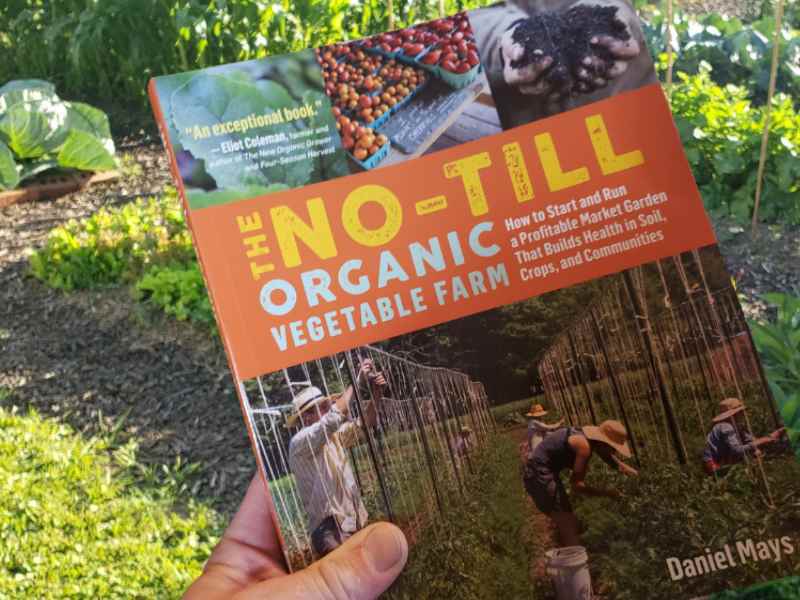“The No-Till Organic Vegetable Farm: How to Start and Run a Profitable Market Garden That Builds Health in Soil, Crops, and Communities” by Daniel Mays is a practical guide for anyone interested in no-till farming. Filled with color photos, clear and informative drawings, and well-organized charts, this book is as visually appealing as it is informative.

It presents a step-by-step guide to no-till farming, providing insight into maintaining soil health, increasing productivity, managing weeds, and reducing costs. It’s not just a guide to avoiding tillage; it offers a holistic approach to farming that enriches the soil, crops, and the community.
Practicality and Efficiency
The book emphasizes the use of practical and efficient no-till practices, such as how to manage large tarps, and offers a fresh perspective on farming that welcomes gradual transition to no-till methods, making it a valuable resource for farmers at different stages of no-till adoption.
Mays also touches on some less-commonly discussed topics such as acquiring capital, designing and setting out drainage and irrigation systems, and integrating livestock in a vegetable farm, making the book comprehensive and well-rounded.
The Story of Frith Farm
Mays’ journey of establishing Frith Farm in Scarborough, Maine, in 2010 forms the backbone of the book. Starting with a modest acreage, a crumbling house and barn, and an expensive education with little practical farming skills, Mays transformed his farm into a successful business that now supplies a 150-member CSA, four natural food stores, a farmers’ market, and a farm stand, generating about $300,000 worth of food annually.
- Mays, Daniel (Author)
- English (Publication Language)
- 240 Pages – 11/10/2020 (Publication Date) – Storey Publishing, LLC (Publisher)
Last update on 2024-07-26 / Affiliate links / Images from Amazon Product Advertising API
Farm Layout and Soil Management
The book delves into the specifics of farm layout and soil management, with Mays recommending consistent bed dimensions to increase the amount of growing space and minimize erosion. He shares practical tips such as the need for initial soil testing and the judicious use of compost in the first year to jump-start soil health.
The use of mulch, such as leaves, straw, and woodchips, is also emphasized as a crucial practice once biological soil health is established.
Bed Establishment and Seedling Production
Mays provides multiple methods to establish new beds, from tilling to smothering plants with tarps and creating beds using thick mulch. The book gives detailed instructions on each method, making it easy for farmers to choose the approach that suits their needs best.
The importance of seedling production is highlighted at Frith Farm, with transplanting fitting well with no-till practices. Practical tools such as sawhorse-topped custom pallets are recommended for saving time in transferring flats.
Irrigation and Pest Control
The book provides a detailed explanation of irrigation practices, including considerations about well depth, flow, recharge rates, costs, and water quality. It also offers guidance on choosing between drip irrigation and sprinklers, even going as far as to recommend specific products and strategies for their use.
Regarding pest control, Mays advocates working towards being a No-Spray farm as well as No-Till, considering pests and diseases as indicators of imbalance and underlying issues with soil health, crop rotation, and biodiversity.
Weed Management
The book begins its chapter on weed management with a thought-provoking statement: “Our need to till arises from the presence of weeds, which in turn proliferate because we till.” Weeds are nature’s way of ensuring that soil is always covered and teeming with roots.
The so-called “simple” solution of preventing weeds from going to seed can reduce work in the long run, but it does require more effort initially. This approach depends on working only the amount of land that you have sufficient skilled labor to manage.
Regarding cover crops, it is recommended to sow a cover crop mix after harvest to increase soil fertility and organic matter, and also to suppress weeds. A special tool called a “roller crimper” can be used to terminate the cover crop without having to resort to tillage.
Harvesting
The book also provides insights into how the farm manages harvest and post-harvest activities. It is recommended to plan for a good workflow and efficient use of time. This includes having all the necessary tools at hand, and creating a space for cleaning, packing, and storage that allows for efficient movement of produce from the field to the customer. Detailed records are kept to monitor yields and sales, which aids in planning for future seasons.
Conclusion
“The No-Till Organic Vegetable Farm” concludes by emphasizing the importance of community in the farming process. This includes not only the human community involved in the work of the farm, but also the broader ecological community of plants, animals, and microorganisms that contribute to the health and productivity of the farm.
This holistic perspective underscores the interconnectedness of all elements of the farming system and emphasizes the importance of working in harmony with nature.




